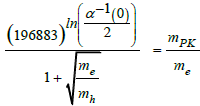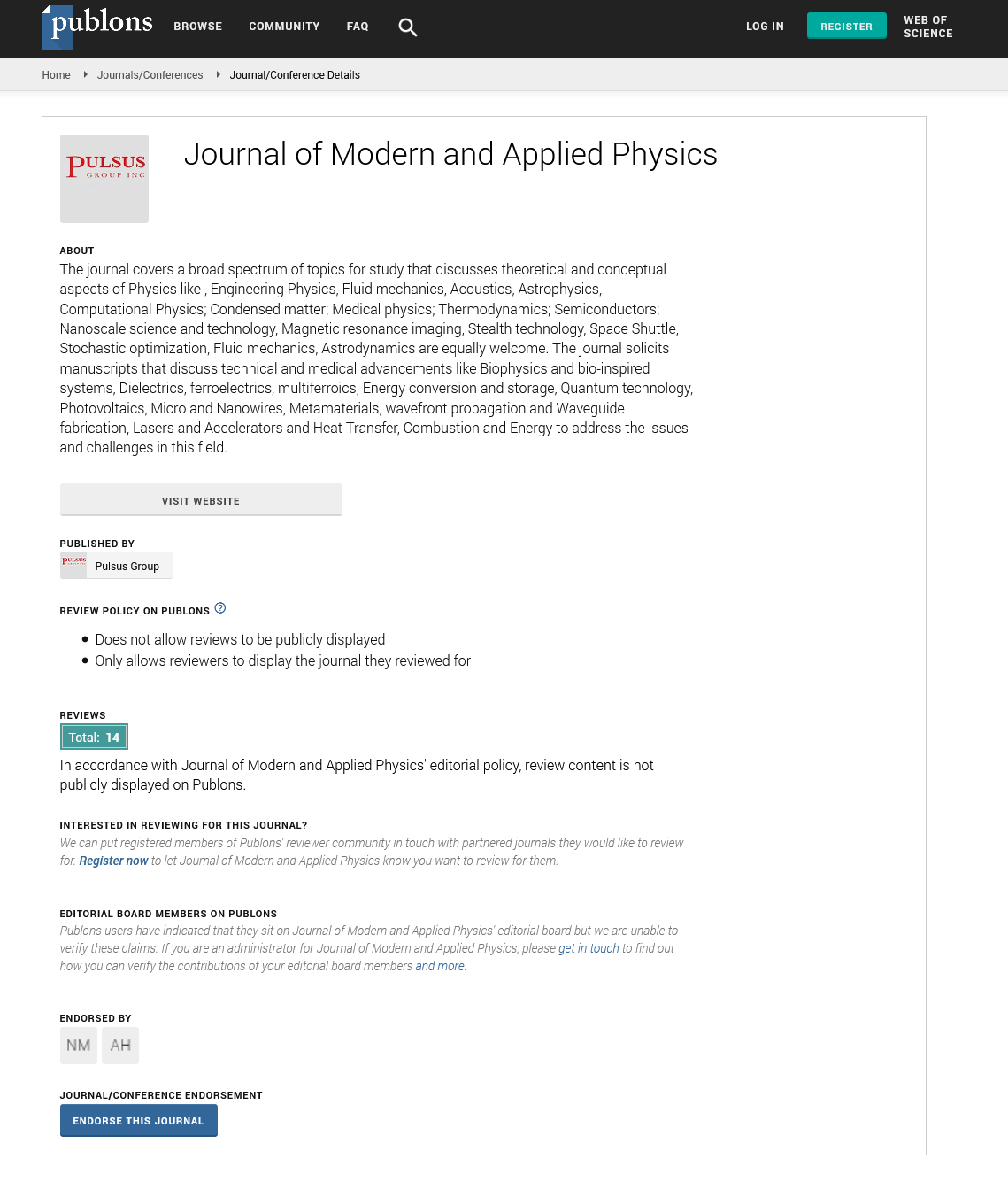E. Witten`s conjecture about the entropy of black holes and the relationship of the monster group with string theory
Received: 12-Feb-2023, Manuscript No. puljmap-23-6155; Editor assigned: 14-Feb-2023, Pre QC No. puljmap-23-6155(PQ); Accepted Date: Feb 24, 2023; Reviewed: 17-Feb-2023 QC No. puljmap-23-6155(Q); Revised: 20-Feb-2023, Manuscript No. puljmap-23-6155(R); Published: 28-Feb-2023, DOI: 10.37532.2022.6.1.1-4
Citation: Doz G.A. E. Witten`s conjecture about the entropy of Black holes and the relationship of the monster group with string theory. J Mod Appl Phys. 2023, 6(1):1-4.
This open-access article is distributed under the terms of the Creative Commons Attribution Non-Commercial License (CC BY-NC) (http://creativecommons.org/licenses/by-nc/4.0/), which permits reuse, distribution and reproduction of the article, provided that the original work is properly cited and the reuse is restricted to noncommercial purposes. For commercial reuse, contact reprints@pulsus.com
Abstract
In 2007, E. Witten suggested that AdS/CFT correspondence yields a duality between pure quantum gravity in (2+1)-dimensional anti de Sitter space and extremal holomorphic CFTs. E.Witten found in the low-mass regime, there is a small quantum correction to the entropy, e.g., the lowest energy primary fields yield ln(196883) ˜12.19, while the Bekenstein Hawking estimate gives 4π ˜12.57. In this work we show how this conjecture is probably correct, calculating in a theoretical-heuristic way this entropy that, indeed, match with that conjectured by E.Witten, is correct and its relationship with the monster group. This relationship is revealed by the last two equations that we present whose probability of being coincidental, we honestly think is zero
Key Words
Bekenstein-Hawking, Quantum mechanics, repulsive force, graviton.
Introduction
The general theory of relativity cannot adequately describe thegravitational quantum properties of black holes, for the simple reason that the RG theory is a purely classical mathematical physical theory [1-2]. Due to this fact, and there is not yet a quantum mechanical theory of gravity, it is necessary to use other alternative theories such as, for example, string theory [3]. The mathematical successes of this last theory and its consistency will not be enumerated. But it will be noted that it is the only theory that can most likely unify gravity with quantum mechanics. For this attempt of unication not only its theoretical development will suffice, otherwise, the development of experiments that can give us an empirical support that is variable and derivable from theoretical predictions will also be essential.
One among other alternative experiments, It could be the simulation in the laboratory of black holes, and measure the entropy of these simulations of black holes. Within a more refined version of these latter experiments one could pretend to measure and deduce the type of radiation emitted by these simulated black holes. The main problem with this type of simulations is the accuracy of their properties with real black holes. Our work focuses, mainly, on the entropy conjectured by E.Witten, or its dimensionless value expressed by ln(1968-83). Onthe other hand, a series of axioms will be introduced from whichwe will derive the main consequences. Some of these axioms bebased on the absence of certain properties of black holes derived from the general theory of relativity and totally disagree with quantum mechanics.
The main incompatibility of the theory of GR is the existence of the singularity of a black hole. That is to say: the existence of a point entity of zero radiuses. This presumed singularity cannot exist according to quantum mechanics, since according to Heisenberg's uncertainty principle for a zero-size radius, the uncertainty of the energy would be infinite [4]. And we know perfectly well that infinities indicate that a theory fails in its limit of applicability. Therefore, the time space must necessarily be quantized to a limit size and that this limit will naturally be the Planck length.
We must ask ourselves why a black hole does not disappear by its own force of gravitational attraction and that by increasing its mass by capturing mass from its surroundings its surface increases, which is a measure of your entropy or amount of information, as is well known.
Our proposal to this question is that inside the black holes there is a compensatory repulsive force that maintains its size and increases it by engulfing mass from its surroundings. This repulsive force would be of the same nature as the repulsive force of the quantum vacuum, which manifests itself in the accelerated expansion of the universe and in the abnormally high speeds of rotation within galaxies.
It is also possible to attribute this repulsive force to the existence of gravitons inside the black hole.
All of the above would lead to a modification of gravity that would explain the quantum nature of black holes and the numerous gravitational effects not explained by the GR theory. Among these unexplained effects would be the discrepancies observed among the perihelion within the solar system. Another effect would be the abnormal annual increase of the Earth-Sun distance and the Earth-Moon distance. And evidently the abnormal speeds of rotation within the galaxies. All these effects could point to the repulsive nature of the quantum vacuum and derived from a quantum theory of gravitation that would include the GR in its classic limit, but also unify the aspects of quantum mechanics.
We must establish axioms or postulates that are of an elementary logic and that reconcile the quantum mechanics and the gravity treated from the point of view of string theory. These elementary premises must be derived from the internal logic of string theory itself. On the other hand, when a black hole is formed, the information should not be lost, since the black hole is a previous transformation of a previous configuration of matter based on protons and neutrons, or a neutron star. Therefore, a black hole must encode in its properties all the previous information, such as: mass ratios such as the mass of Planck in relation to the mass of the electron, etc. From the above it is derived that the radiation of a black hole or not is thermal (emission of particles increasingly massive as its mass is reduced) or its information is not lost, for example, due to soft photons and gravitons by conjecture of Hawking.
A strong indication that this information is emitted in its radiation is precisely the difference between 4Pi and ln(196883), as we will show in a theoretical heuristic way. Attending to these elementary premises, the following fundamental premises derived from the logic of string theory will be established:
1) In a black hole, time is stopped or ceases to exist as a dimension within the event horizon. This implies that the postulate of quantum mechanics is fulfilled that a particle can be both at different spatial sites and at the same time in different states.
2) The holographic principle manifests itself as the information
encoded on the surface of a sphere [5]. According to the
string theory that we adopt in this work, the quantity of
dimensions is that of 26, the primitive theory of Bosonic
strings that includes the graviton [6-7]. If a black hole is
purely gravitational, then its surface is formed by circular
closed strings or gravitons. Likewise, the four dimensions
must be encoded on its surface, as well as the twenty-six
dimensions. Effectively the surface of a sphere is exactly the
sum of the surface of four circles, this is 
3) The reduction of the twenty-six dimensions to the eleven
dimensions of the theory M, would be due to the
dimensions expressed as the sum of the state of projections
of all the possible spins (maximum spin of the graviton), this
is: [8].
[8].
4) The generating dimension of the monster group ln(196883) would actually be the number of mutually connected hyperspheres in twenty-six dimensions (grid in 26 dimensions) [9].
5) The Heisenberg uncertainty principle is what allows the evaporation of a black hole [10, 11]. This means that the gravitons or circles are vibrating indeterminately. When a graviton leaves the surface emitting, for example, two photons, the circular hole left on the surface of the event horizon is closed by the attraction of the rest of the vibrating circles-gravitons of the surface of said horizon of the black hole.
This effect reduces both the mass and the surface of the black hole [12].
The uncertainty principle of Heisenberg must be extended, then, to the dimensions, according to the following known equation:

The proof of the existence of the seven dimensions rolled in
circles (11d-4d), it is precisely the ratio of the mass of the Higgs
boson to the mass of the electron, as we have shown in our
previous articles. And it is based on the Heisenberg uncertainty
principle for 7 dimensions [13]. This ratio is exactly (matrix of 7
Higgs bosons or seven dimensions):
In this paper, two types of equation results will be presented:
a) Theoretical heuristic equations.
b) Empirical-heuristic equations whose probability of chance can be considered null.
Graphically the surface of the black hole by the hypothesis of closed strings or gravitons is shown in the following figure.1
Black hole emission process
As we have already mentioned, closed strings or gravitons do not have a position determined by the uncertainty principle. Because of this it is possible for a graviton to escape from the event horizon and decay into other particles. In the low energy regime, the most logical and probable thing is that it decays into two photons and these, in turn, into an electron-positron pair. Therefore, if we maintain the hypothesis that the emission of a black hole is not thermal, that is to say: when the temperature of the black hole increases, the gravitons can decay into other particles, such as two Z bosons [14]. This process would continue throughout the entire evaporation time of the black hole.
Quantum mechanical calculations of the entropy of a black hole and conformation of E.Witten’s hypothesis
When the black hole has a huge mass, like those in the nuclei of galaxies, its emission energy is very small, so we expect emission of photons and electron positron pairs [15-16].
Fraction of electron-positron pairs for a zero momentum electromagnetic fine structure constant, i.e.: for the vacuum.
Under these conditions and considering the Planck mass, the fraction of electrons or their entropy will be:

This first correction gives us entropy of:

At a certain moment the temperature of the evaporating black hole will be high enough for a graviton to decay into two Z bosons, and these in turn into particle-antiparticle pairs of the standard model [17-19]. For a minimum energy we can consider that the Z bosons decay into an electron-positron pair.
This reasoning leads us to a positive correction heuristic term given by the following equation:

Considering this new correction, we have that the entropy acquires the following value:

As can be seen, the previous equation gives us a precision of five decimal places with respect to ln(196883)
Empirical heuristic final term starting from the hypothesis that the entropy conjectured by E.Witten is given for the entire range of energies, then it is logical to suppose that perhaps a correction term could be due to the GUT theories, with the X and Y bosons [20-23].

The empirical heuristic negative term found is given by the equation:

The final equation for entropy, adding this last correction gives the following result:

This gives us a precision of eight decimal places with respect to ln(196883).
Conclusion
Applying simple reasoning from string theory and quantum mechanics, we consider E.Witten’s conjecture about the entropy of black holes given by the value ln(196883) is probably correct.
Until there is a quantum theory of gravity, both the result with the theoretical heuristic treatment presented here, as well as E.Witten's conjecture should be corroborated by this future theory.
We must be very cautious and see how progress is made in certain theoretical directions
Remark 1. An amazing equation that relates the monster group and the mass of the electron.

This last equation is practically impossible, that it can be casual, since together with its great simplicity closely related terms such as the fine structure constant for zero momentum and the mass of the electron and the Planck mass are involved.
Recall that thefine structure constant of electromagnetism is the probability that an electron emits or absorbs a photon.
mh=Higgs boson mass=125.25 Gev ± 0.17 Gev
We think that the monster group, and perhaps its subgroups, is an essential part of a quantum theory of gravity and even for a theory of unication of all forces (electromagnetism, weak force and quarks). One more sample of this possibility is shown in the following two equations, very simple and of great beauty, in which the dimension 196883 of the monster group are present.
mh=Higgs boson mass
e=Euler's number

Higgs vacuum ratio (converted to mass) electron mass VH=Higgs vacuum value= 246.219640239262 GeV

References
- Lin YH, Pei D. Holomorphic CFTs and topological modular forms. Commun. Math. Phys. 2023:1-8.
- Hawking SW. Black hole explosions? Nature. 1974, 248(5443):30-1.
- Saha S, Karmakar NC. Atman (Soul) carries Karma to the next life and beyond, a narrative review with scientific perspectives.
- Sen D. The uncertainty relations in quantum mechanics. Current Science. 2014:203-18.
- Susskind L. The world as a hologram. J. Math. Phys. 1995,36(11):6377-96.
- D'Hoker E, Phong DH. The geometry of string perturbation theory. Rev. Mod. Phys.1988, 60(4):917.
- Polchinski JG. String theory, volume I: An introduction to the bosonic string. Cambridge.1998.
- Parekh S. Introduction to String Theory. SSRN 4009963. 2022.
- Bekenstein JD. Universal upper bound on the entropy-to-energy ratio for bounded systems. Physical Review D. 1981, 23(2):287.
- Visser M. Essential and inessential features of Hawking radiation. Int. J. Mod. Phys. D .2003, 12(04):649-61.
- Wheeler JA, Zurek WH, editors. Quantum theory and measurement. Princet. Univ. Press 2014.
- Lee YJ, Stan A. An infinite-dimensional Heisenberg uncertainty principle. Taiwanese J. of Math. 1999, 3(4):529-38.
- Garces A. On the possibility of a new principle of equivalence and its relation with a string theory based on the foundations of quantum mechanics.
- Hagiwara K, Hikasa K, Nakamura K, et al. Review of particle properties. Physical Review D. 2002,66(1):010001.
- Georgi H, Glashow SL. Unity of all elementary-particle forces. Phys. Rev. Lett. 1974, 32(8):438.
- Buras AJ, Ellis J, Gaillard MK, et al. Aspects of the grand unification of strong, weak and electromagnetic interactions. Nucl. Phys. B. 1978, 135(1):66-92.
- Witten E. Three-dimensional gravity revisited. arXiv preprint. 2007.
- Borcherds RE. Modular moonshine, III. Euclid
- Strichartz RS. A guide to distribution theory and Fourier transforms. World Sci. Publ. Co. 2003.
- Bekenstein JD. Universal upper bound on the entropy-to-energy ratio for bounded systems. Physical Review D. 1981, 23(2):287.
- Roos M, Porter FC, Aguilar-Benitez M,et al. Review of particle properties: Particle Data group. Physics Letters B. 1982,111:i.
- Langacker P. Grand unification. Scholarpedia. 2012, 7(10):11419.
- Black hole thermodynamics. 2023






